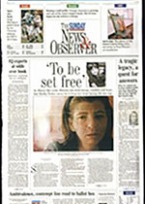 My students write profiles, and this is a very hard concept for them to get. And for all of us, it can be hard to pull off, especially if we are fond of the profile subject. One student — caught making up a profile — complained that I had told her to dig up dirt on her subject.
My students write profiles, and this is a very hard concept for them to get. And for all of us, it can be hard to pull off, especially if we are fond of the profile subject. One student — caught making up a profile — complained that I had told her to dig up dirt on her subject.
I didn’t, but this nuance of profile writing can be hard to explain. I usually use myself as an example. If you were writing a profile of me, you might note that I wore a sweater to class inside out – twice. I wouldn’t like it, but I’m not the customer — the reade
ells you something about me.
The key is to make this approach clear to the subject before hand. I once wrote about a young woman who was in the limbo of late-stage cystic fibrosis. Her father cried when talking about her. I put it in the story, and he later bristled a bit. But it was one of the most powerful parts of the piece.
A fellow writing teacher gave me a great exercise to help with this lesson. Think of someone you like. Then, think of something you don’t like about him or her. There you go.
All that said, I appreciated this column from the NYTImes public editor:
The best profiles are written “warts and all” — not as valentines to their subjects but as full-blown representations of a real person. (Some classic examples of the genre are gathered in “The Woman at the Washington Zoo,” by Marjorie Williams.) When profiles are nuanced, though, as in Mr. Eligon’s generally fair-minded look at Michael Brown, this very quality can run against reader expectations.
What to do about this disconnection? Journalists can go the extra mile in making the news value and purpose of a piece extremely clear in the article’s “nut graf,” the paragraph high in the story that explains its purpose. They can be aware that, whether intended or not, a New York Times profile often has the effect of casting a certain glow, even a halo, around an individual — scientist, designer or hawkish intellectual.
And readers can do their part by understanding profiles are not supposed to be love letters. In fact, the best ones are nothing of the kind.
Here, Phillip Seymour Hoffman as the fictional version of Lester Bangs advises the fictional version of teenage Rolling Stone writer Cameron Crowe. who is struggling over a band profile.
